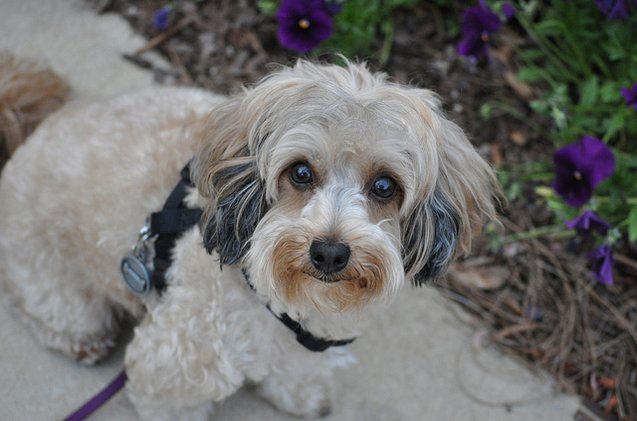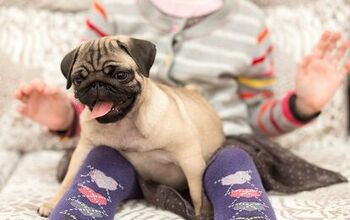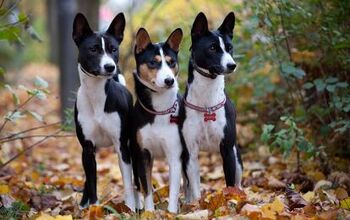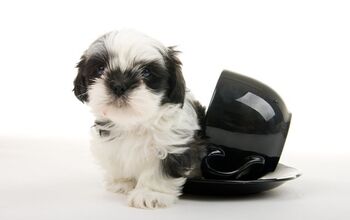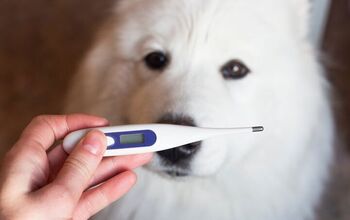Maltipoo


About Maltipoo
Maltipoo Basics
The Maltese Poodle mix is a popular designer dog for a good reason – the combination of two hypoallergenic, cute dogs results in a new breed that inherits the best traits from both parents. Not only is the Maltipoo as sweet as they come, but they have all it takes to be a fantastic companion dog. This is a pup that will steal your heart and you’ll never get it back. The major downside of owning one is merely that you’ll have a hard time accepting any other breed of dog ever again. Once you go Maltipoo, no other pooch will ever do!
This designer dog was developed by crossing purebred Poodle and Maltese to create a new breed of designer dog that will have all of the traits of a perfect companion dog, from their low-shedding hypoallergenic fur to small stature and loveable personalities. The breed is officially recognized under two names – Maltipoo and Malt-A-Poo – but has various alternative names you can find it under. These include Malti-Doodle, Malt-A-Doodle, Maltedoodle, Malt-oodle, Malt-A-Poo, Malti-Poodle, Maltesepoo, Maltese-Poodle, Maltesedoodle, Moodle, and Multa-Poo. Whew! That sure is a lot of names for a Maltese Poodle mix, but considering their immense popularity, it doesn’t come as a big surprise that people have been figuring out different names and labels for their adorable hybrids.
The Maltipoo is generally friendly and outgoing. This pup will act as if everyone in the world is his best bud. The love goes both ways, too. It’s inescapable. People simply can’t resist the Maltipoo’s soft coat and spunky attitude. Maltipoos are easy to train because they are very intelligent and eager to please their owners. This crossbreed is the perfect dog for first-time dog owners or for those living in small spaces with no yards, such as an apartment or a condo. They will fill those small spaces with their spunky energy, but thankfully your stuff will be safe from any doggy destruction.
Maltipoos are bred to be hypoallergenic dogs. However, not all puppies will grow to fulfill this hope. If allergies are the reason for getting a Maltipoo puppy, make sure to check your reactions first. You should spend a considerable amount of time with with your puppy and others from the litter to ensure that your allergies won’t kick in. Let’s face it; nobody wants to get a new puppy only to have to give him up weeks later due to allergy problems. So putting in the effort early will save you some heartbreak, even if it’ll be tough to tear yourself away from the adorable little of Maltese Poodle puppies once you start having a reaction.
Origin
Unfortunately, there is still quite a bit we don’t know about the history of designer dog breeds, but the biggest mystery about them is their origin. Apart from the popular Labradoodle, not many hybrid breeds have a well-documented history. What we now think of as designer dogs were considered little more mutts by pure breed dog snobs for so long that no one bothered to chronicle their official origin. In many instances, the first litter likely came about by accident. We simply don’t know where most of these beautiful brands of pup came from, unlike many of the more established pure bred doggos.
When it comes to the Maltipoo and their history, it’s not that different from most of their mixed breed fellows. The Maltese Poodle mix was created in the United States, sometime in the last 20 to 30 years. The Maltipoo dog was created by breeders to be a small and affectionate companion. Their intended role is to be a wonderful pet that would fit into any family’s lifestyle. Simple as that. The original breeders certainly hit their mark. There’s simply no denying that the Maltipoo is a great companion for almost any family. Both the Poodle and the Maltese are popular dog breeds, so combining the two together was thought to bring out the best in both breeds. This is a pup designed to be loved and after a few minutes in their presence, you’ll be more than happy to comply.
Pedigree
The American Kennel Club doesn’t recognize designer dog breed and sadly the Maltipoo is no exception. As a result, you can’t register a litter of these crossbreed puppies for official pedigree papers. Of course, even without documentation to prove it, this designer dog boasts an impressive family tree. All you need to do is look at their parents to see that.
The hybrid dog known as the Maltipoo is the result of breeding a purebred Poodle to a purebred Maltese. Both of the parents are in good standing with AKC and are breeds that have been popular pets and companions for centuries. Put them together and you just might have the ultimate lovable pup! When you directly cross two purebred dogs, their litter is considered to be a so-called first generation mix. These are 50/50 mixes, but that doesn’t mean that every puppy from the litter will be a balanced combination of both parental breeds. In fact, these are considered to be the most unpredictable hybrids, in terms of their appearance and traits – there’s simply no way to accurately guess which parent the puppies will take up after. Some will look more like a Poodle, others like a Maltese.
This is one of the reasons why designer dogs are not recognized by the official canine organizations – there is no breed standard to talk about, so they can’t really consider them a “real” breed”. Of course, the original plan for this crossbreeding was to develop a dog that was hypoallergenic, non-shedding, and highly trainable. For this to happen, there have to be multigenerational breedings that could create a more standardized look and temperament in this hybrid breed. In other words, breeders would breed a dog that’s a first generation Maltipoo with either other unrelated Maltipoos, Maltesers, or Poodles – depending on what the ultimate goal is. If they want to ensure a hypoallergenic breed, their multigenerational mixes would incorporate more Poodle genes, and so on.
However, it takes a few generations for hybrids like the Maltipoo to develop predictable pups. At the moment, it’s impossible to guarantee which qualities that your Maltipoo will take from either of their popular parents. Thankfully, all of the qualities of their parents tend to be desirable and similar. So, this isn’t particularly noticeable in Maltipoos, like it can be with other designer dog breeds.
Food/Diet
Maltipoos are high-energy dogs crammed into small packages and need a diet that is specifically formulated for them. To meet their unique nutritional needs, it’s best to settle on a diet rooted in high-quality dry dog food. Kibble is packed with all the essential nutrients in the right ratios, and it’s the most convenient way to provide a well-balanced diet to your pet. Of course, to consider any dry dog food nutritionally balanced, you need to take a careful look at the ingredient list. The first ingredient on the list should be real meat, preferably from a single protein source to minimize the potential of allergic reactions, followed by other wholesome, natural foods. The formula should contain healthy fats that provide omega 3 and 6, such as fish oil or flaxseed, and complex carbs to give your energetic little Maltipoo energy to run around and play, as well as fiber to support optimal digestion. Naturally, don’t forget about the variety of vitamins and minerals your pet needs to thrive – the manufacturer should fortify their food with nutrients if need be! For the Maltipoo, you should pick out dry food that’s suitable for their age (puppy, adult, senior), size (small) and activity level (low to moderate).
Obviously, not all dogs are the same. So if you are worried about what food will work best for your Maltese Poodle mix, it might be worth consulting with your vet. They will have a better sense of what your doggo needs than any kibble manufacturer.
As a small breed dog, the Maltipoo will be prone and oral health issues. A quality diet can help postpone tooth loss or prevent it altogether. In addition to healthy food, you should offer dental treats for cleaning plaque and brush regularly, too. There are even toys available that double as teeth cleaners. So, it will be easy to find a system that works for you and your pup.
Like some other small breeds, the Maltipoo can also become obese if not fed properly. Poor diet in large amounts, combined with lack of exercise, can quickly leave your little friend fat and unhappy. Lethargy, arthritis, and digestive problems are not far to follow. So make sure you pay attention to the diet, and provide your friend with ample exercise. While the Maltipoo is great as a snoozy and cuddly lap dog, they also have their energetic side! They will love to play!
Training
Training a Poodle and Maltese mix is quite easy, provided the trainer is calm and caring. Maltipoos might be highly intelligent, but they are extremely sensitive as well. This designer dog responds only to positive reinforcement training methods. Harsh words, yelling or aggressive tactics will force the dog to shut down and cower. This will significantly harm the possibility of training. Not to mention that these aversive training methods will damage the relationship between you and your pet. This is closer to abuse than training and should be avoided at all costs. Instead, rely on gentle “bribes” to get your pooch to behave. Yummy treats and excited praise will have the Maltipoo thrilled to start his training sessions and keep him interested in working, too. You’ll be amazed how quickly you’ll be able to train these pups with a gentle touch.
In addition to being fast learners when it comes to housebreaking and simple commands, Maltipoos can excel in obedience and agility settings. They also make great therapy dogs. These dogs bring joy wherever they go.
It is important to start training your Maltipoo from an early age. Encourage them to meet new dogs and strangers, so they can quickly overcome their fear of new “faces”. If you fail to do this, your adult Maltipoo might be snappy and temperamental, having that all too common “small dog attitude”. This can result in some embarrassing situations down the road. Proper socialization while they are still puppies will ensure that they grow up into friendly and goofy doggos that will love to make friendships wherever they are. Of course, it also helps eliminate any possibility of separation anxiety, excess barking, and chewed up furniture. It’s all about that early patient training!
Weight
Mixed breed dogs can often have varying looks and traits, but the Maltese Poodle mix is generally quite consistent. That’s both in terms of the puppy’s appearance and behavior! The reason for this is that the tiny Maltese is bred to a Toy or Miniature Poodle that’s similar in size and looks, so there’s not much room for surprise. Maltipoos weigh between 5 and 20 pounds and stand between 8 and 14 inches tall at the withers. Females are usually smaller than male puppies. Generally considered a small breed, the Maltipoo won’t require tons of space. Apartments can work great for them, as long as the environment is not too constraining or tiny. This is a welcome change in comparison to some other large breeds. Of course, no dog, no matter the size, can spend a long time cooped up indoors. Maltipoos are energetic and spunky, and will love to take walks and run around in the yard. Make sure you provide this!
Temperament/Behavior
Mild-mannered and generally calm, the Maltipoo is a great family companion for those willing to spend a lot of time with the dog. This hybrid pup loves his people and attaches to them quickly. However, this strong dog-to-human bond can be problematic as Maltipoos often suffer from separation anxiety. They can become depressed and even cause harm to themselves by pulling out their own coats or chewing on their skin. Maltipoos do best when a family member is with them all of the time. This makes them ideal companions for seniors, or people who work from home. Anyone who tends to be away from home for long periods of time wouldn’t be an ideal Maltipoo owner.
The Maltipoo is energetic and full of spunk, enough for all of his family members to enjoy. He’ll happily chase after a ball or even play tag with the kids. The Maltese Poodle mix get along with other pets too. Then after a tough day of play, he will curl up on your lap for some much deserved attention and a comfortable nap. If trained and socialized properly, the Maltipoo will become a wonderful family pet. Of course, there will always be that one special person with whom they will create the strongest bond. Still, they’ll be wonderful companions, equally cuddly and playful, and great around children. It’s all about the environment – when surrounded by loving people, the Maltipoo will respond in equal measure!
Common Health Problems
Because the Maltipoo is a crossbreed, he is susceptible to problems that affect both the Maltese and the Poodle. These health problems could include Legg-Calve-Perthes Disease, Portosystemic Shunt, Patellar Luxation, Progressive Retinal Atrophy, Epilepsy, and White Shaker Syndrome. Skin problems can also be an issue with this hybrid breed, especially if the puppy has a white coat. Food and skin allergies, as well as increased skin sensitivity, are something to look out for with these designer dogs. So, it’s worth booking regular and consistent appointments with your vet to catch any of these potential problem quickly and treat them immediately.
Life Expectancy
The average Maltipoo lives to be between 10 and 13 years old. When most dog breeds are considered, this lifespan can be placed somewhere right in the middle! It’s on the higher average side, and makes Maltipoos a generally long-lived breed. When you consider all their traits and their friendly character, you’ll understand that they are quite the companion pets. If you were looking for a stout but petit four-legged friend, this might be it!
Exercise
Although quite energetic, the Poodle and Maltese mix doesn’t require much exercise. A short brisk walk in the morning and evening will be more than enough exercise to keep the pooch happy. This little fellow loves to play and will happily chase a ball across the floor for hours. As a result, he makes a great playmate for well-behaved and caring children. The Maltipoo is an ideal dog for those who live in small apartments in the city, but is also more than happy to live in the suburbs with a yard of his own. Of course, the Maltipoo should never be left off leash to run unless he is in a fenced yard or secure dog park. That’s true of all pups, after all. Just make sure you are ready to meet Maltipoo’s energy levels! Sometimes these can be high, as these tiny pups would seem ready to run for hours on end!
Recognized Clubs
The Maltipoo is not recognized by the American Kennel Club because it is not considered to be a purebred dog. The registries that do recognize this crossbreed are American Canine Hybrid Club, Designer Dogs Kennel Club, Designer Breed Registry, International Designer Canine Registry and the Designer Breed Registry. There are several prominent Maltipoo Clubs and non-profit organizations that are centered on dedicated Maltipoo breeders and enthusiasts. They are aimed at providing all the important information about this hybrid breed, and to push on towards recognition by the American Kennel Club. These clubs and societies are a great way to learn all that there is about this unique breed and to make sure you know all that’s important before getting one for yourself.
Coat
Maltipoo coats can vary widely. Some are poker straight while others may be wavy or curly. The colors are varied from white to black and everywhere in between.
Brushing is essential to keep the Maltipoo’s coat in tiptop condition. He should be brushed several times each week to prevent any snarls or mats from forming. A shampoo with a deep conditioner is necessary every month. Both of its parents require professional grooming, too, so it’s safe to assume their offspring is no different. Count on having to take them to a salon for a trim from time to time, to keep their soft hair in check.
Puppies
Usually, there are around 4 to 6 puppies in a Maltipoo litter – they could all look alike, or be completely different to one another. One puppy might have white coat with curly hair, another can be bi-colored with wavy hair, and so on. Designer puppies are like a box of chocolates – you never know what you are going to get, but you know you’ll love them either way. Maltipoo puppies are cute, but they are also quite fragile. Caution must be taken when allowing young children to hold them as they could be easily injured. Always supervise play, either with kids or bigger dogs, and be mindful of your new pet’s petite size. Even so, puppyhood is the ideal time to start with teaching your new pet how to behave. When done properly and on time, training and socialization will ensure that a Maltipoo puppy grows up to be a lovely, friendly dog. Most people start with some simple commands when the puppy first comes home, around the two month mark, just to ease them in the process. Between 12 and 16 weeks of age is when owners usually start potty training their pet, and after that, you can go on to teaching more complex commands.
The Poodle and Maltese mix is one of the most popular designer dog breeds out there. It’s easy to see why. From their adorable looks to their sweetly loving personalities and their easy trainability, everything about Maltipoos makes them a perfect companion. Whether you’re a single, a senior, or have a family with children, a Maltipoo will fit easily into your home and become your new four-legged best friend. It’s simply impossible not to fall for these gorgeous pups!

Amy Tokic, Editor of PetGuide.com, is a passionate animal lover and proud pet parent of Oscar, a Shih Tzu/Chihuahua cross, and Zed, a Japanese Chin. Her love of animals began in kindergarten, when she brought her stuffed dog Snoopy into class with her every day. Now, she writes about her adventures in pet ownership and tirelessly researches products, news and health related issues she can share with other animal enthusiasts. In her free time, Amy loves perusing used book and record stores, obsessing over the latest pet products available and chasing squirrels with wild abandon (a habit attributed to spending too much time with her pooches).
More by Amy Tokic



